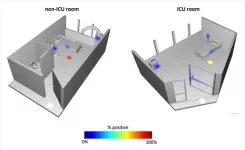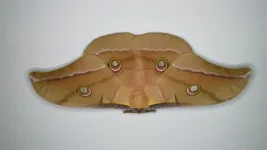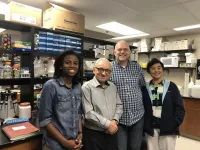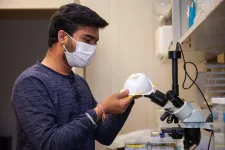(Press-News.org) Watching what was happening around the world in early 2020, University of California San Diego School of Medicine researchers knew their region would likely soon be hit with a wave of patients with COVID-19, the infection caused by the coronavirus SARS-CoV-2. They wondered how the virus persists on surfaces, particularly in hospitals, and they knew they had only a small window of time to get started if they wanted to capture a snapshot of the "before" situation -- before patients with the infection were admitted.
After a call late one Sunday night, a team assembled in the hospital lobby the next day, ready to swab.
In the resulting study, described June 8, 2021 in Microbiome, researchers swabbed patient room surfaces before, during and after occupancy, and repeatedly collected samples from the skin, noses and stool of COVID-19 patients and their health care workers over time. In total, they tested 972 hospital-associated samples for traces of SARS-CoV-2 over two months.
"Although it feels like we've been living with this virus for a long time, the study of the interactions between SARS-CoV-2 and other microbes is still new, and we still have a lot of questions," said co-senior author Sarah Allard, PhD, assistant project scientist at UC San Diego School of Medicine and Scripps Institution of Oceanography. "The more we know about how a virus interacts with its environment, the better we can understand how it's transmitted and how we might best disrupt transmission to prevent and treat the disease."
Their findings: The virus, or at least its genetic signature, abounds. The team detected the virus on the floors next to the beds of patients with COVID-19 (39 percent of samples tested), floors outside patient rooms (29 percent) and surfaces inside the rooms (16 percent). SARS-CoV-2 detection tended to be highest during the first five days after a patient's onset of symptoms.
The researchers are quick to point out that just because they can detect the virus' unique genetic signatures on a surface, it doesn't mean the virus is able to infect people. Since they started the study, it has been well documented that SARS-CoV-2 spreads primarily through close human interactions, while surface transmission is likely very rare. What's more, none of the health care workers actively caring for patients in the study tested positive for the virus. The study focused on one hospital, but the researchers expect they would find similar results in any hospital treating patients with COVID-19.
"This is huge on so many levels," said co-senior author Daniel Sweeney, MD, critical care and infectious disease physician at UC San Diego Health. "We need to know if our personal protective equipment, PPE, is adequate, and fortunately we know now that things like masks, gloves, gowns and face shields really do work. This pandemic has been a global disaster, but it could've been even worse if our health care workers were getting infected, especially if we didn't know why."
Viruses don't typically hang out alone. Whether on people or surfaces, they are part of complex communities known as microbiomes, which may include a variety of other viruses, bacteria and additional microbes. In looking for the coronavirus, the team discovered something else: one particular type of bacteria from the genus Rothia was found alongside SARS-CoV-2 more often than not, regardless of collection site. In other words, the presence of Rothia strongly predicted that they would also detect SARS-CoV-2 in the same sample.
"Why that relationship?" asked Allard. "Does the bacteria help the virus survive, or vice versa? Or is it just that these bacteria are associated with the underlying medical conditions that put patients at higher risk for severe COVID-19 in the first place? That's an area for future research."
The study was a challenge from the beginning, and became more difficult as the hospital's intensive care unit began to take in more patients with COVID-19. The team specifically designed their approach to leverage existing resources to not stress the supply chain needed for clinical care and testing. In a separate effort, some of the team and their colleagues developed alternative swabs for research purposes. They collected samples as quickly and as efficiently as possible to minimize disruption to patient care. The samples were transported back to the lab in alcohol, preserving the virus for analysis but not exposing researchers to active organisms.
"A lot of people did a lot of basic and clinical research these last few months, and we did it well," Sweeney said. "We added to our infrastructure. We acquired the experience. I hope the same sort of focus, drive and spirit carry forward in whatever comes next."
INFORMATION:
Co-authors of the study include: Clarisse Marotz, Pedro Belda-Ferre, Farhana Ali, Promi Das, Shi Huang, Kalen Cantrell, Lingjing Jiang, Cameron Martino, Rachel E. Diner, Gibraan Rahman, Daniel McDonald, George Armstrong, Sho Kodera, Sonya Donato, Gertrude Ecklu-Mensah, Neil Gottel, Mariana C Salas Garcia, Leslie Y. Chiang, Rodolfo A. Salido, Justin P. Shaffer, MacKenzie Bryant, Karenina Sanders, Greg Humphrey, Gail Ackermann, Laxmi Parida, Yoshiki Vázquez-Baeza, Francesca J. Torriani, Rob Knight, Jack Gilbert, UC San Diego; Niina Haiminen, IBM, T.J. Watson Research Center; Kristen L. Beck, Ho-Cheol Kim, IBM Research-Almaden; and Anna Paola Carrieri, IBM Research UK.
MELVILLE, N.Y., June 9, 2021 -- In the evolutionary battle between hunter and hunted, sound plays an integral part in the success or failure of the hunt. In the case of bats vs. moths, the insects are using acoustics against their winged foes.
During the 180th Meeting of the Acoustical Society of America, which will be held virtually June 8-10, Thomas Neil, from the University of Bristol, will discuss how moth wings have evolved in composition and structure to help them create anti-bat defenses. The session, "Moth wings are acoustic metamaterials," will take place Wednesday, June 9, at 1 p.m. Eastern U.S.
Nocturnal moths ...
MELVILLE, N.Y., June 9, 2021 -- The prolonged impact of the COVID-19 pandemic and the interaction restrictions created widespread lockdown fatigue and increased social tension in multiunit housing. But small improvements in quality-of-life routines may help people cope with the health restrictions better than they previously could.
During the 180th Meeting of the Acoustical Society of America, which will be held virtually June 8-10, Braxton Boren, from American University, will discuss noise prevention techniques and the use of alterative acoustic stimulation to help those who find themselves in pandemic-related lockdowns. The session, "The Soundscape of Quarantine," will take place Wednesday, June 9, at 1:45 p.m. Eastern U.S.
While there have been studies about ...
The SARS-CoV-2 papain-like protease (PLpro) plays an essential role in processing viral proteins needed for replication. In addition, the enzyme can cut and inactivate some human proteins important for an immune response. Now, researchers reporting in ACS Infectious Diseases have found other targets of PLpro in the human proteome, including proteins involved in cardiovascular function, blood clotting and inflammation, suggesting a link between the inactivation of these proteins and COVID-19 symptoms.
Viruses like SARS-CoV-2 make multiple proteins as one long "polyprotein." Viral enzymes called proteases recognize specific amino acid sequences in this polyprotein and cut them to release individual proteins. ...
A cell-penetrating peptide developed by researchers at Vanderbilt University Medical Center can prevent, in an animal model, the often-fatal septic shock that can result from bacterial and viral infections.
Their findings, published this week in Scientific Reports, could lead to a way to protect patients at highest risk for severe complications and death from out-of-control inflammatory responses to microbial infections, including COVID-19.
"Life-threatening microbial inflammation hits harder (in) patients with metabolic syndrome, a condition afflicting millions of people in the United States and worldwide," said the paper's corresponding author, Jacek Hawiger, MD, PhD, the Louise B. McGavock Chair in Medicine and Distinguished Professor of Medicine ...
BRIEFING NOTE: Researchers will announce these results at the 238th AAS meeting on Wednesday, June 9 at 12:15 p.m. E.D.T. Press registration details can be found here: https://aas.org/meetings/aas238/press. Interested journalists can also tune in to AAS briefings streamed live at: https://www.youtube.com/c/AASPressOffice. Please note that you will not be able to ask questions via YouTube; to ask questions, you'll need to register for the meeting and join the briefings via Zoom. Recordings will be archived on the AAS Press Office YouTube channel afterward.
To catch sight of a fast radio burst is to be extremely lucky in where and when you point your radio dish. Fast radio bursts, or FRBs, are oddly bright flashes of light, registering ...
OAKLAND, Calif. -- The significant declines in heart attack hospitalizations and emergency care for possible strokes seen in Northern California at the beginning of the COVID-19 pandemic were not seen in subsequent surges, new research from Kaiser Permanente shows.
The study, published June 2 in JAMA, suggests public health campaigns that encouraged people to seek care if they were experiencing signs or symptoms of a stroke or heart attack were effective.
"In May 2020, we reported that, in the early months of the pandemic, the weekly number of patients admitted to our hospitals for a heart attack fell to nearly half of what would be expected," said the study's lead author Matthew ...
A new study identifies a novel biomarker indicating resilience to chronic stress. This biomarker is largely absent in people suffering from major depressive disorder, and this absence is further associated with pessimism in daily life, the study finds.
Nature Communications published the research by scientists at Emory University.
The researchers used brain imaging to identify differences in the neurotransmitter glutamate within the medial prefrontal cortex before and after study participants underwent stressful tasks. They then followed the participants for four weeks, using a survey protocol to regularly assess how participants rated their expected and experienced outcomes for daily activities.
"To our knowledge, this is the first work to show ...
A new study published in the Journal of the American Geriatrics Society suggests that survival rates after heart transplant surgery are similar in adults ages 18 to 69 and adults ages 70 and older.
Researchers examined a large U.S. database of patients who were listed as candidates for surgery to replace their failing hearts with healthier donor hearts. The researchers found that:
Only 1 in 50 people who are considered for heart transplant surgery and 1 in 50 people who receive a heart transplant are ages 70 or older.
For older adults in the study, the likelihood of surviving one or five years after a heart transplant was about the same as for younger adults.
Having a ...
Early in her career neuroscientist Allyson Mackey began thinking about molars. As a researcher who studies brain development, she wanted to know whether when these teeth arrived might indicate early maturation in children.
"I've long been concerned that if kids grow up too fast, their brains will mature too fast and will lose plasticity at an earlier age. Then they'll go into school and have trouble learning at the same rate as their peers," says Mackey, an assistant professor in the Department of Psychology at Penn. "Of course, not every kid who experiences stress or [is] low income will show this pattern of accelerated development."
What would help, she thought, was a scalable, objective way—a physical manifestation, ...
Even the best face masks work only as well as their fit.
And poorly fitting face masks greatly increase the risk of infection from airborne pathogens compared to custom-fitted masks, according to a new study by the University of Cincinnati.
Researchers in UC's College of Engineering and Applied Science used computerized tomography or CT scans of three different-sized face masks attached to three different-sized dummy heads to measure the gaps between the face and the fabric. Then they calculated the leaks from these gaps to determine the infection risk.
They found that while N95 masks are effective barriers against airborne diseases like COVID-19, poorly ...



